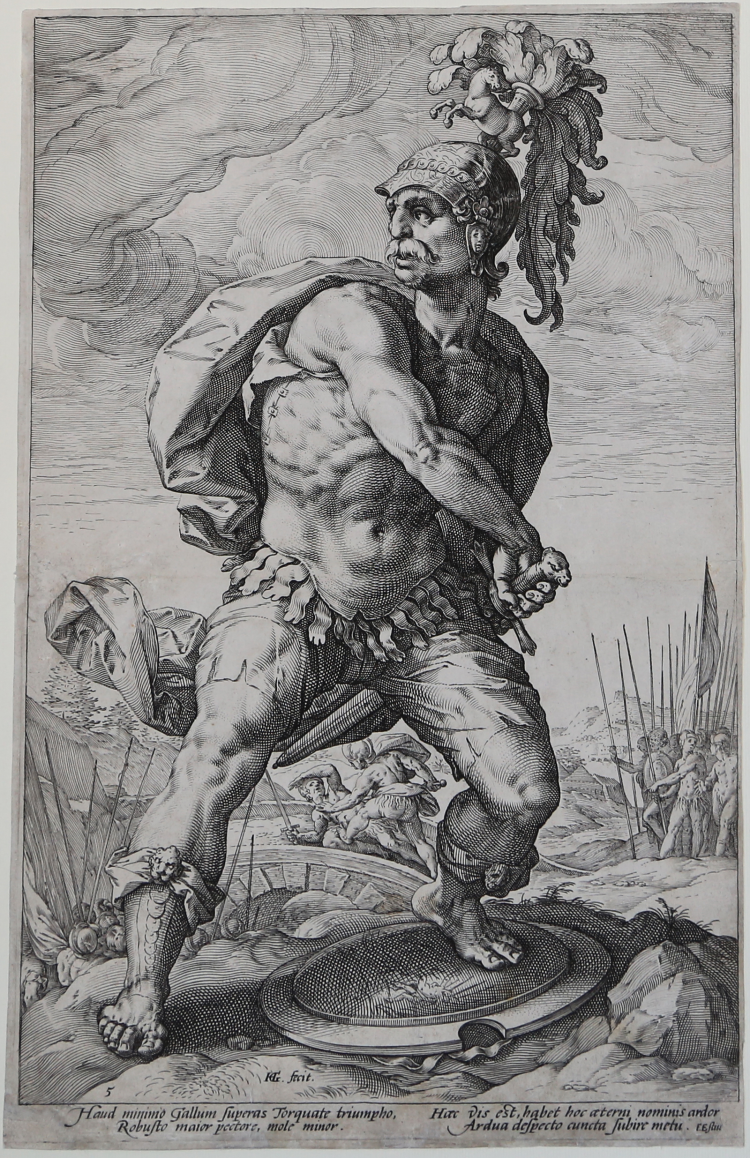




| Reference: | S32754 |
| Author | Hendrick GOLTZIUS |
| Year: | 1586 |
| Measures: | 232 x 368 mm |



| Reference: | S32754 |
| Author | Hendrick GOLTZIUS |
| Year: | 1586 |
| Measures: | 232 x 368 mm |
Engraving, 1586, signed on plate in lower left corner "HG. fecit." and numbered "5".
Beautiful example, printed on contemporary laid paper with watermark “crowned coat of Arms with fleur-de-Lis”, trimmed to the paltearm, small expert reapairs at the left sideand at the lower right corner, otherwise in good condition.
With two columns of text, each two lines "Haud minimo Gallum ... subire metu" provided by Franco Estius. From the series Memorabilia aliquot Romanae strenuitatis exempla, better known as “The Roman Heroes”.
The hero Titus Manlius Torquatus, whole-length, wearing a plumed helmet, leaning back with one foot on a shield and drawing his sword from its scabbard. In the background you can see how he defeats a gigantic Gaul on a bridge.
In 361 BC, Titus Manlius fought in the army of Titus Quinctius Poenus against the Gauls The Gauls had a giant among them, who - presenting himself as the champion of his tribe - bragged about his force and invincibility, and challenged the Roman commander Manlius. In single combat, Manlius slaughtered his opponent. He took the dead giant's gold collar and wore it himself, which lead to his second (nick)name Torquatus (torques meaning collar).
This print is part of a series of ten prints, consisting of an unnumbered titlepage, eight numbered representations of heroes and an unnumbered final print.
The series, printed in Haarlem in 1586 was dedicated to Emperor Rudolph II.
|
Hirschmann 1921 166; Hollstein 166.II; New Hollstein (Dutch & Flemish) 168.II (Hendrick Goltzius); Strauss 1977 235; Bartsch III.35.100.
|
Hendrick GOLTZIUS (Mulbrecht 1559 - Haarlem 1617)
|
Dutch painter and engraver, was born at Millebrecht, in the duchy of Julich.
After studying painting on glass for some years under his father, he was taught the use of the burin by Dirk Volkertszoon Coornlert, a Dutch engraver of mediocre attainment, whom he soon surpassed, but who retained his services for his own advantage. He was also employed by Philip Galle to engrave a set of prints of the history of Lucretia.
At the age of twenty-one he married a widow somewhat advanced in years, whose money enabled him to establish at Haarlem an independent business; however his unpleasant relations with her so affected his health that he found it advisable in 1590 to make a tour through Germany to Italy, where he acquired an intense admiration for the works of Michelangelo, which led him to surpass that master in the grotesqueness and extravagance of his designs. He returned to Haarlem considerably improved in health, and laboured there at his art till his death.
Goltzius ought not to be judged chiefly by the works he valued most, his eccentric imitations of Michelangelo. His portraits, though mostly miniatures, are master-pieces of their kind, both on account of their exquisite finish, and as fine studies of individual character. Of his larger heads, the life-size portrait of himself is probably the most striking example. His master-pieces, so called from their being attempts to imitate the style of the old masters, have perhaps been overpraised.
In his command of the burin Goltzius is not surpassed even by Dürr; but his technical skill is often unequally aided by higher artistic qualities. Even, however, his eccentricities and extravagances are greatly counterbalanced by the beauty and freedom of his execution. He began painting at the age of forty-two, but none of his works in this branch of art--some of which are in the imperial collection at Vienna--display any special excellences. He also executed a few pieces in chiaroscuro.
|
|
Hirschmann 1921 166; Hollstein 166.II; New Hollstein (Dutch & Flemish) 168.II (Hendrick Goltzius); Strauss 1977 235; Bartsch III.35.100.
|
Hendrick GOLTZIUS (Mulbrecht 1559 - Haarlem 1617)
|
Dutch painter and engraver, was born at Millebrecht, in the duchy of Julich.
After studying painting on glass for some years under his father, he was taught the use of the burin by Dirk Volkertszoon Coornlert, a Dutch engraver of mediocre attainment, whom he soon surpassed, but who retained his services for his own advantage. He was also employed by Philip Galle to engrave a set of prints of the history of Lucretia.
At the age of twenty-one he married a widow somewhat advanced in years, whose money enabled him to establish at Haarlem an independent business; however his unpleasant relations with her so affected his health that he found it advisable in 1590 to make a tour through Germany to Italy, where he acquired an intense admiration for the works of Michelangelo, which led him to surpass that master in the grotesqueness and extravagance of his designs. He returned to Haarlem considerably improved in health, and laboured there at his art till his death.
Goltzius ought not to be judged chiefly by the works he valued most, his eccentric imitations of Michelangelo. His portraits, though mostly miniatures, are master-pieces of their kind, both on account of their exquisite finish, and as fine studies of individual character. Of his larger heads, the life-size portrait of himself is probably the most striking example. His master-pieces, so called from their being attempts to imitate the style of the old masters, have perhaps been overpraised.
In his command of the burin Goltzius is not surpassed even by Dürr; but his technical skill is often unequally aided by higher artistic qualities. Even, however, his eccentricities and extravagances are greatly counterbalanced by the beauty and freedom of his execution. He began painting at the age of forty-two, but none of his works in this branch of art--some of which are in the imperial collection at Vienna--display any special excellences. He also executed a few pieces in chiaroscuro.
|